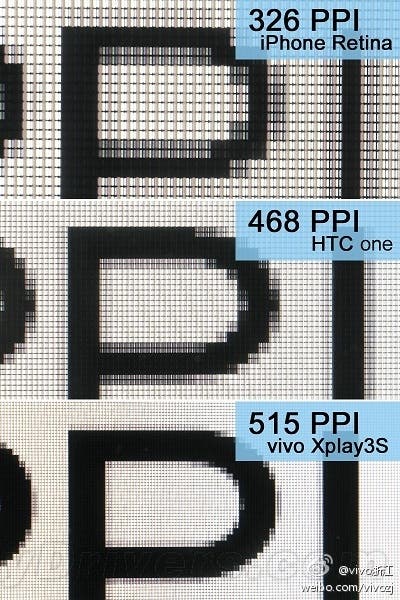There has been a lot of excitement around the Vivo Xplay 3S and it’s 2560 x 1440 resolution display, but just how much of a difference will all those extra pixels make?
The jury is still out on whether we really need phones with 2K (2560 x 1440) resolution displays, but manufacturers are waiting for the verdict and are ploughing ahead to bring super high resolution phones to stores very soon.
One of the first could be the 5.7-inch Vivo Xplay 3S which would have a pixel density of 515ppi. To put that into perspective the iPhone’s retina display is 326ppi and the 1920 x 1080 screen on the HTC One has a pixel density of 468ppi. Of course these are all just numbers, how will this actually look on the phone itself? Well the magnified image below pits the iPhone, HTC One and Vivo Xplay 3S panels head to head.

Obviously this is looking the screens under magnification and we still don’t know if we will actually be able to see the differences with the naked eye.
The Vivo Xplay should launch in December with 4G LTE and a Snapdragon 800 processor.
[ Source ]




I cannot see any possible reason for this other that bragging rights , maybe thats enough for some one to buy this phone rather than another with a so called inferior screen .I have good eyesight and even the 1080p phone i have seems over kill . Maybe 1 or 2% of the population may see some differance? .perhaps on a 6 1/2″ screen.
In my experience with full HD smartphones, I would say that you can actually see the difference, but not all the time. It is noticeable when you’re watching full HD movies, viewing pictures or playing games, especially ona larger display. Certain applications can also use the extra resolution. However, if you are going to pack it with such a display, you’d better have well optimized software (Vivo is good at this) and a large battery. If not, it’s still pretty obscure.
Years ago, if you had a small T.V. you could buy a magnifying glass and make a 14″ portable into a 40-50″ monster set. The only problem was, the picture got all pixely and blocky.
This is the reverse, so I imagine one of the huge lens viewing things would be great and suddenly you have a 40″ room size TV (ambient light allowing) without the need for a huge tv. Just a thought. 🙂
I dont think a normal human eye can see pixels beyond 300ppi. So anything above 300ppi is overkill.
Surely it is easy to work out if we can see the difference?
People do it all the time with TVs.
You just need the dot pitch and the distance from the screen to the eye.
Pretty well known formula…
Look up Visual Acuity Viewing Distance….
The human eye at best can see 1/60 of an arc
Trigonometry is a wonderful thing…
I see dead pixels
u stole my lines 😛